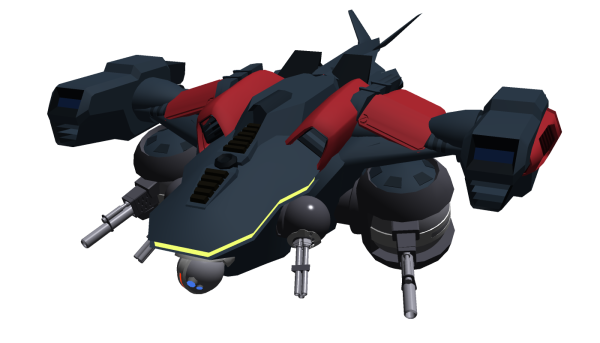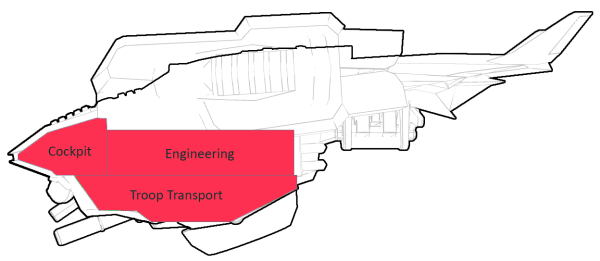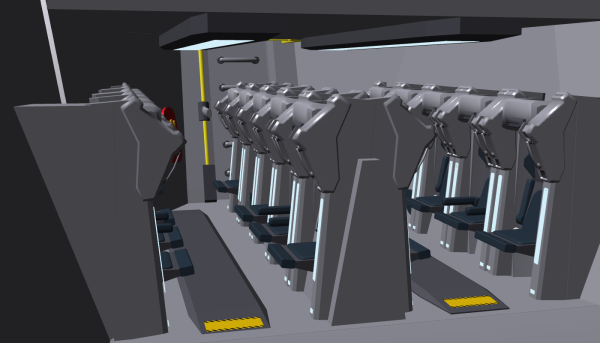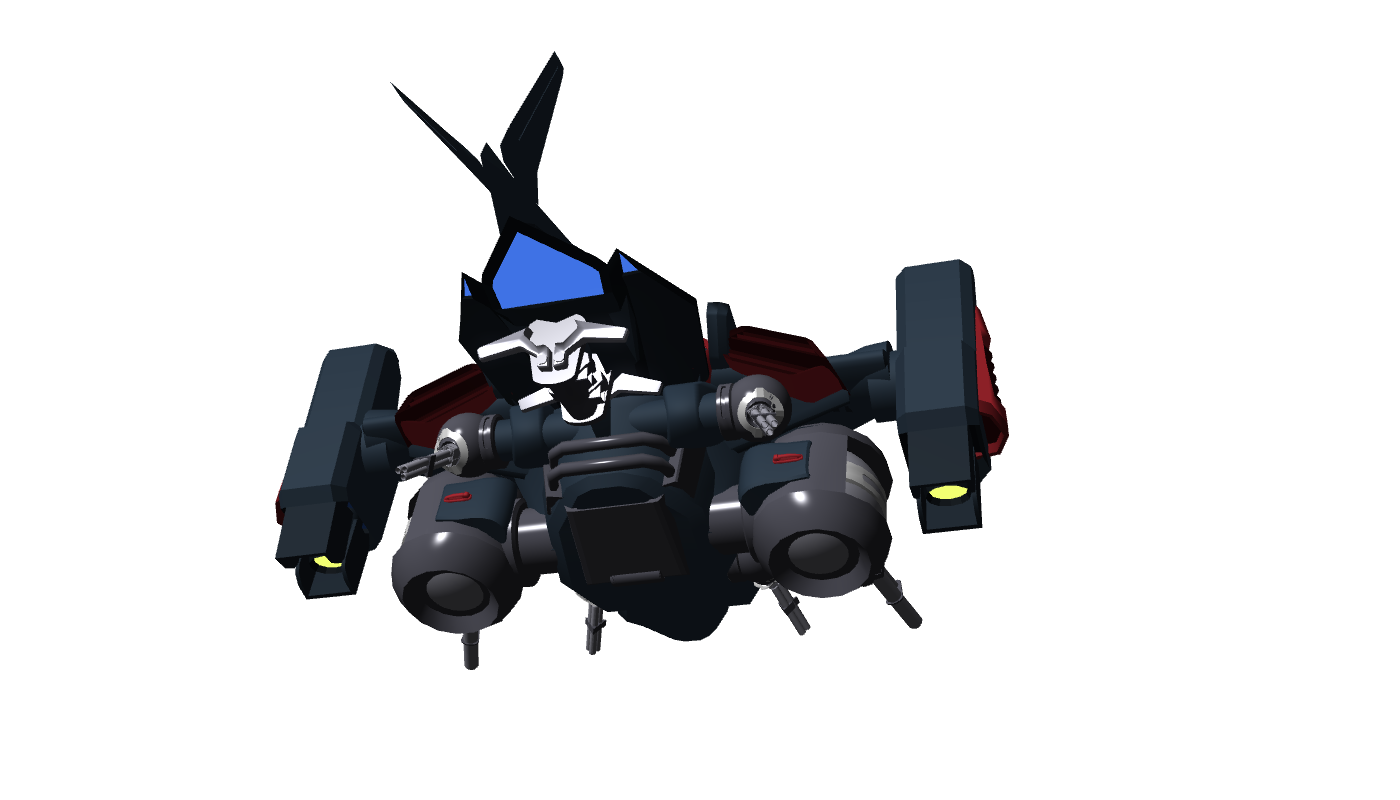Sidebar
Table of Contents
BW-TC-1A Hellcat-class Tactical Dropship
The BW-TC-1A is a versatile craft, introduced in YE 41, designed to support battle operations of all types. Commonly known as the “Hellcat” among its development team, it features impressive weaponry, stealth capabilities, cargo space for troops or equipment, and a retractable “capture” system that can carry small to medium ground vehicles.
About the Craft
Designed to give and take a beating, the Hellcat is intended to drop off its cargo of troops, equipment, or armor, then hang back to provide fire support for as long as the assets require it. It can also act as an escort for dedicated transports, such as the S6-VTOLT "Hammer".
Key Features
Important functions of this craft.
- Troop Transportation
- Capacity: 20 Troops with or without Power Armor
- Vehicle or Module Transportation
- Can carry two light vehicles or a single medium vehicle, such as the BW-MRGT "Hound" or Hydra Variable Tank in its rear section.
- Fire support comes from two large heavy turrets and four medium Gatling turrets
- Weapons can 'tag' targets and track them automatically
- Weapons can be fired separately or linked in any combination
- Built-in stealth capabilities, including advanced ECM.
- Load, speed, and discharging weapons may have an adverse effect on the Hellcat's stealth functions
- Semi-autonomous operation by way of an Autonomous Mech AI “EVE”
- Space and atmosphere capable
Mission Specialization
These are the main roles this craft can fill as needed.
- Rapid Troop Transport and Insertion
- Small/Medium Vehicle Transport
- Ground Combat Support
History
During the development of the BW-VTOLT "Hammer", a question was posed - “What if we need to insert a small group of operatives into a hotly contested area?” The Hammer was an excellent transport for wide-scale assault situations, but it lacked in firepower and stealth capabilities. The D.O.E., with their focus on the Hammer and other projects, kicked the project over to Department Of Advanced Research And Development (D.O.A.R.A.D.). An engineer named Waylan Vulca and his team took on the challenge.
What they designed was a versatile craft, intended to fill the NDC's various support and aerial superiority gaps. The “Hellcat” easily ran through its early paces. The one hitch in the project was deciding on the number of operators required to pilot the craft. Waylan was insistent that such a craft should be able to operate with only a single pilot, while the other engineers on the team were firm on three. After pressure from others, he relented and the Hellcat can now support up to three operators in an 'upgraded' cockpit area.
Too stubborn to be defeated entirely, Waylan designed each operator 'station' to be fully capable of operating the entire craft. A combination of AI and ergonomic controls at each pilot station ensures that responsibilities are easily managed and/or delegated. In truth, the entire craft can be run on auto-pilot by voice or mental command alone using a Autonomous Mech AI “EVE”.
Appearance
The Hellcat features an angular body and six weapons turrets. The two 'wing' turrets are considerably larger than the forward turrets and boast large cannons. The forward and rear turrets, while smaller, are rotary chain-guns with impressive fire rates. Situated between the two forward chain-gun turrets is a spherical sensor package that, among other things, assists in the Hellcat's target 'painting' capabilities.
Mounted on either side of the craft are two large VTOL engines. These primarily assist in recoil compensation for the craft's armaments and in lifting heavy loads. They are capable of pivoting independently to improve pilot control and craft stability. The top of the craft features two long intakes that feed into the Hellcat's rear engines.
Mounted on the rear of the Hellcat, below the engines, is a 'capture' system that can retrieve large objects from the ground. It can attach to an object either magnetically or with large physical clamps. The retrieval system can be lowered via a series of thick cables to allow the Hellcat to pick up/drop off vehicles without landing. The troop bay door is located in front of the retrieval system. It is a single door that swings downwards, creating a ramp when open. Sufficient space is available to allow for troops to disembark while the Hellcat is carrying a vehicle.
Statistical Information
- Organization: New Dusk Conclave
- Type: Fire Support Dropship
- Class: BW-TC-1A
- Designer: Waylan Vulca, by way of the Department Of Advanced Research And Development (D.O.A.R.A.D.) and the Department Of Fleet Development (D.O.F.D.)
- Manufacturer: Black Wing Enterprises
- Fielded by: NDC Ground Forces "Duskerian Legion", and Conclave Aerospace and Fleet Forces (C.A.F.F.)
- Price: Not available for commercial sales
- Crew: 1 Minimum, 3 Recommended
- Maximum Crew Capacity: 3 Seated, plus 2 Standing Non-operators
- Passenger Capacity: 20 Troops with or without Power Armor
- Length: 25 meters
- Width: 22 meters
- Height: 7 meters
Propulsion and Range
- Falcon Tunnel Drive: 0.2ly/m for a maximum of 15ly range
- Sublight Engines: .275c, mach 1.5
- Range: 2 weeks for supplies, 3 months for fuel
- Lifespan: 10 years without maintenance, 20 years with maintenance.
- Refit Cycle: 3 years
Damage Capacity
See Damage Rating (Version 3) for an explanation of the damage system.
- DRv3 Tier: 9
- Shields: T9
Interior
The Hellcat's interior is comprised of three main sections. The cockpit is designed for up to three pilots. Behind the cockpit is an engineering area, allowing access to crucial parts of the flight, weapons, and life support systems. Below both is the troop bay, designed to hold up to twenty troops and their gear. Movement from the top section to the lower section is done by a ladder to the front of the troop bay.
Cockpit
The Hellcat's cockpit area contains three identical stations. One is placed forwards and the other two are back and to the sides, forming a triangle.
Cockpit Stations
Each station features two joysticks and two foot pedals, as well as three primary, curved main screens and a number of supplementary mechanical instruments. A knob between the legs can rotate the user's station, such that all three stations can face in whatever direction the operator desires. A protected toggle next to the knob allows the Hellcat to control the operator's facing, adjusting their position based on the direction the craft is traveling, target tracking, and so on in an intuitive fashion. The screens also support touch controls and eye-tracking.
Together, the three main screens provide a 180 degree view of the Hellcat's surroundings that tracks the direction the user is looking in. The two side screens can be folded back when not needed or to allow easier entry into the station's seat.
The Hellcat features a dynamic piloting system that allows the craft to be smoothly operated by one to three pilots with assistance from EVE.
Crew Compartments
Not truly a separate room, the rear of the Hellcat's cockpit features four wide cabinets built into the walls, separated by the door to the Engineering Compartment. One side features two cot compartments that can be revealed by lowering their doors. The other side has one cot compartment and a storage compartment. The compartment doors are armored and lockable, providing a secure location for the crew in the event that the craft has been boarded.
Crew can sleep in the cots with the door opened or closed. A screen is built into the compartment's ceiling, which can be used for recreational purposes or tied into the ship's main controls to adjust flight patterns, etc. In emergencies, EVE can transfer all controls to these screens and lockout the pilot stations entirely.
The storage compartment opens in the same fashion as the cot compartments. The door can slide forward and lock into place, providing a surface to set food on. Built in heating elements can be used to cook food using the compartment's standard cookware and utensils.
The Hellcat carries enough supplies to support the crew and standard troop compliment for its normal operating window.
Engineering
A long, narrow corridor runs from the bulkhead at the rear of the cockpit through much of the length of the Hellcat. A control panel is present to report on the Hellcat's overall 'health' and to allow skilled operators to make adjustments.
Easily removed panels line the walls and provide access to the various systems within. Hearing protection is advised due to the noise produced by the various machinery and engine components. Air-tight panels on either side of the ceiling can be lowered to provide access to a cramped corridor allowing access to the Hellcat's primary engine and gravity control systems. When lowered, the panels reveal built-in steps, similar to an attic door.
Despite the access available, full repairs to a damaged Hellcat cannot always be made from within the craft.
Troop Compartment
The rear troop compartment features four rows of seats with reinforced lockers behind each. The default configuration allows for twenty troops in power armor to sit comfortably and securely. A locker above the seat can hold the troop's supplies. Additional storage is present behind the back of the seat for additional weapons and gear.
Medical kits are positioned at the fore and aft of the compartment, stationed beside either door. When loaded out for power armor, one or more medical kits can be easily replaced with power armor repair and maintenance equipment.
Exit from the Hellcat is by way of a large rear door. The door is designed to offer sufficient room for egress even when the Hellcat is carrying vehicles. Both rows of troops can exit simultaneously without interfering with each other.
Ship Systems
Armored Hull and Hull Integrated Systems
The Hellcat has a Tier 9 rated hull that is composed mainly of Durandium Alloy, with a sub structure of ADNR (Aggregated Diamond Nanorods) and kinetic resistant gel. The hull has an outer layer of Madite-C for stealth and armor purposes. Electronic Camouflage System dispersal ports are standard on the hull for when stealth is needed.
Computers and Electronics
The Hellcat features an NDC standard graphene based computer system for managing the majority of its onboard operations. Its customized AI setup and cockpit control stations have been improved, as noted below.
To assist with its stealth features, the Hellcat also features advanced ECM, EWF systems, and shielding from external interference via a Madite-C shell.
Emergency Systems
In the event of a crash, the Hellcat has similar emergency systems to its sister craft, the S6-VTOLT "Hammer".
Life Support Systems
A oxygen purifier keeps the air breathable for up to 3 months until it's filters need to be replaced, as well as storage system for oxygen supply. Fresh air encountered when landing on livable planets, is drawn in through a vent system in the hull to refill these occasionally. Heating units are installed under the deck to keep compartments warm through out the ship.
Propulsion
The craft is pushed along by two sets of Helix Plasma Engines, which run off the same plasma drive, which uses 6 BW-PC-1A Plasma Core as a fuel and power source. They are designed to be highly efficient and to recycle as much fuel as possible that might otherwise have been lost as waste. Two of the thrusters are large for the craft's size and can rotate to provide hover and VTOL capabilities.
Additional propulsion and lift is provided by a gravitic drive system. When the Hellcat is not carrying a load, it is possible to fly the gunship using the gravitic drives only.
Shield Systems
The BW-TC-1A uses conformal shaped shields, which are a combination of magnetic and charged energy based fields. This protects the craft adequately from fast moving projectiles, as well as acts as an integrity field for the hull, allowing the craft to withstand additional stress.
Stealth Systems
A combination of electronics, passive stealth materials, and a variable drive system make up the stealth features of the Hellcat. Passive stealth is provided by a Madite-C external shell, which naturally dissipates RADAR and similar detection signals. The Hellcat can fly by way of its gravitic drive or its thrusters, giving pilots options when it comes to avoiding detection. Lastly, the craft's advanced array of anti-detection electronics round out the craft's stealth system.
Heat is one of the Hellcat's challenges, however. In order to improve stealth from ground-based detection systems, the majority of the craft's heat is shunted topside. While this is an intentional part of the Hellcat's anti-stealth measures, it can be noticeable for craft above the Hellcat who know what to look for.
In space, heat management is provided via passive radiation within the craft's air intake/exhaust, effectively reducing its overall heat signature.
Weapons Systems
The Hellcat features six rapid-tracking turrets arranged around the body of the vessel to give it excellent weapons coverage. The Hellcat's weapons are scaled-up versions of existing weapons platforms and utilize existing technology, but at a larger caliber or improved fire rate.
- 2x Mass Accelerated Kinetic Ordinance "MAKO" Tier 11 (Medium Anti-Starship)
- 4x S6-TLAC "Cavalry" Tier 8 (Medium Anti-Mecha)
Each turret contains advanced recoil suppression equipment that is further improved by an AI-assisted thrust compensation. Shots from the large guns can still be felt throughout the craft and may even force it back somewhat, but overall accuracy is unaffected.
Onboard Systems Descriptions
EVE
An onboard support AI, EVE, supports the pilot/s in operating the Hellcat.
The EVE AI assists operators in a number of ways:
- Simple control adjustments that make piloting the craft simpler and more intuitive for pilots new to the Hellcat. Over time, these adjustments are automatically phased out as the pilot becomes more comfortable with the craft.
- Processing piloting and targeting data. The display quickly and reliably identifies friend from foe, incoming threats, and so on. Eye tracking allows EVE to identify targets, items, or functions of interest. A simple glance and joystick button press can designate a target for suppression fire, activate ECMs, vehicle capture, and so on.
- Supplemental control. Functions not being manually controlled are performed by the AI instead. This is most evident in systems like auto-pilot, but can also include fire control, piloting, vehicle capture, landing, and all other functions of the Hellcat. If necessary, EVE can operate the Hellcat autonomously.
Control Configurations
The Hellcat's controls can be modified to fit the operator's current needs through a set of toggles on the joysticks and foot controls on the pedals. Operators can mix-and-match configurations beyond the defaults or rely entirely on 'learned' operations via the EVE AI for a truly customized control schema.
- Standard Configuration
- In this configuration, one joystick operates as flight control and the other operates as weapons control. Foot pedals reduce or increase thrust across each of the Hellcat's engines. The craft can pivot by rotating the flight joystick. Rotating the weapons joystick cycles weapon selection.
- Weapons Configuration
- In this configuration, both joysticks are dedicated to the operation of the Hellcat's weapon turrets. The pilot's screens shift to display a view from each selected turret. As before, weapons can be cycled by rotating each joystick.
- Flight Configuration
- In this configuration, each joystick controls one of the craft's VTOL engines. Side-to-side motion becomes restricted. Forward-and-backward movement adjusts the rotation of each engine, giving the pilot incredible control over the craft's agility. Foot pedals continue to operate as thrust controls. When flying via the gravitic drive only, the controls are the same and the craft behaves similarly, though not at the same level of performance.
In all configurations, the craft protects other operators from having their current operations 'stolen' by other operators. Weapons that are currently being operated cannot be cycled into and flight controls cannot be taken. If an operator leaves their seat or seems unable to adequately fulfill their role (due to health, psychological issues, etc), their access is released and/or blocked entirely.
Cargo Capacity
- 3,200 kg of cargo internally, including 20 troops or 12 stretchers and their equipment
- Two small vehicles or one medium vehicle externally, or an equivalent amount of other cargo or modules
Weight can be freely adjusted between internal and external cargo, but load distribution problems may need to be compensated for.
OOC Notes
| Products & Items Database | |
|---|---|
| Product Categories | small craft |
| Product Name | Hellcat-class Tactical Dropship |
| Nomenclature | BW-TC-1A |
| Manufacturer | Black Wing Enterprises |
| DR v3 max | Tier 9 |
Page Tools
Terms of Service - Privacy Policy





